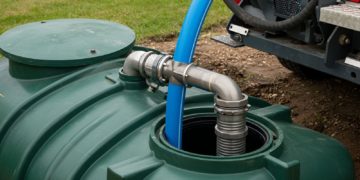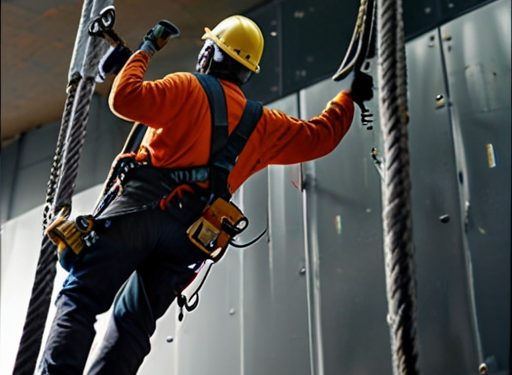In high-risk work environments, where traditional methods may fall short, industrial rope access services have emerged as a revolutionary solution. Whether it’s scaling skyscrapers for maintenance or navigating complex structures in confined spaces, industrial rope access offers unmatched flexibility, safety, and efficiency. This specialized technique, which involves using ropes and specialized equipment to access difficult-to-reach areas, is rapidly gaining popularity across various industries. As companies increasingly recognize the benefits of this approach, the demand for skilled professionals and innovative solutions continues to grow.
Why Industrial Rope Access Services Are Essential
Industrial rope access services are vital in industries where traditional access methods, such as scaffolding or cranes, are either impractical or too costly. This method is widely used in construction, oil and gas, wind energy, and even in the inspection and maintenance of bridges and other infrastructure. The primary advantage of industrial rope access is its ability to provide safe and efficient access to hard-to-reach areas, reducing the time and resources needed for setup and execution.
Key Benefits of Industrial Rope Access Services
● Enhanced Safety: Safety is a top priority in any high-risk environment, and industrial rope access services are designed with this in mind. The method involves rigorous safety protocols, including thorough training for technicians and the use of specialized equipment. This reduces the risk of accidents and ensures that workers can perform their tasks with minimal hazards.
● Cost-Effectiveness: Traditional access methods like scaffolding can be expensive and time-consuming to set up. Industrial rope access eliminates these costs, allowing for quicker deployment and reduced labor expenses. Companies can save significantly on both time and money by opting for this efficient solution.
● Versatility: Industrial rope access is incredibly versatile, making it suitable for a wide range of applications. Whether it’s inspecting a tall structure, performing maintenance in a confined space, or conducting repairs on a remote site, industrial rope access services can be tailored to meet the specific needs of any project.
● Minimal Disruption: One of the significant advantages of industrial rope access is the minimal disruption it causes to ongoing operations. Unlike scaffolding or cranes, which may require a shutdown of the surrounding area, rope access technicians can perform their tasks without interrupting normal business activities.
Industrial Rope Access in Action: Real-World Applications
The versatility and efficiency of industrial rope access services make them ideal for various real-world applications. Here are some of the key areas where this method is making a significant impact:
1. Building Maintenance and Inspection
Skyscrapers and tall structures require regular maintenance and inspections to ensure their safety and longevity. Industrial rope access is the perfect solution for these tasks, allowing technicians to easily access high and difficult-to-reach areas without the need for extensive scaffolding. Whether it’s window cleaning, façade repairs, or structural inspections, rope access provides a quick and effective way to get the job done.
2. Oil and Gas Industry
In the oil and gas industry, where safety is paramount, industrial rope access services are frequently used for the inspection and maintenance of offshore platforms, refineries, and pipelines. The method’s ability to provide access to hard-to-reach areas in challenging environments makes it invaluable in this sector. Rope access technicians can carry out tasks such as non-destructive testing, welding, and painting with minimal disruption to operations.
3. Wind Energy Sector
The wind energy sector also benefits greatly from industrial rope access services. Wind turbines, which are often located in remote areas, require regular inspections and maintenance to operate efficiently. Rope access provides a cost-effective and safe solution for technicians to perform tasks at height, such as blade inspections, repairs, and cleaning.
4. Infrastructure Projects
Bridges, dams, and other large infrastructure projects often present access challenges that are best addressed through industrial rope access. This method allows technicians to perform inspections, repairs, and maintenance in areas that would otherwise be difficult or impossible to reach. The ability to work on these structures without disrupting traffic or other activities makes rope access an ideal choice for infrastructure projects.
The Role of Geofencing Solutions in Enhancing Industrial Rope Access
As technology continues to advance, the integration of geofencing solutions has further enhanced the safety and efficiency of industrial rope access services. Geofencing, a technology that creates virtual boundaries using GPS or RFID, can be used to monitor and manage the movement of workers in hazardous environments.
How Geofencing Solutions Providers Improve Safety
Geofencing solutions providers play a crucial role in enhancing the safety of industrial rope access operations. By setting up virtual boundaries around hazardous areas, companies can monitor the location of workers in real-time and receive alerts if someone enters a restricted zone. This technology is particularly useful in environments where multiple teams are working simultaneously, ensuring that everyone stays within their designated areas and reducing the risk of accidents.
Enhancing Workflow Efficiency
In addition to improving safety, geofencing solutions can also enhance workflow efficiency. By tracking the movement of workers and equipment, companies can optimize the allocation of resources and ensure that tasks are completed on time. This is especially important in large-scale projects where coordination and timing are critical.
Real-Time Data and Reporting
Geofencing solutions providers offer real-time data and reporting capabilities that are invaluable for managing industrial rope access operations. Companies can monitor the progress of tasks, track the location of personnel, and generate detailed reports on the efficiency and safety of the operation. This data can be used to make informed decisions and improve future projects.
Best Practices for Implementing Industrial Rope Access Services
To maximize the benefits of industrial rope access services, it’s essential to follow best practices that ensure safety, efficiency, and effectiveness. Here are some key considerations for companies looking to implement these services:
1. Choose Qualified Technicians
The success of any industrial rope access project depends on the skills and expertise of the technicians involved. Companies should ensure that their rope access teams are highly trained and certified by recognized organizations, such as IRATA (Industrial Rope Access Trade Association) or SPRAT (Society of Professional Rope Access Technicians).
2. Conduct Thorough Risk Assessments
Before starting any project, it’s crucial to conduct a thorough risk assessment to identify potential hazards and develop strategies to mitigate them. This includes assessing the work environment, the equipment to be used, and the specific tasks to be performed.
3. Implement Rigorous Safety Protocols
Safety should always be the top priority in industrial rope access operations. Companies should implement rigorous safety protocols, including regular equipment inspections, proper use of personal protective equipment (PPE), and adherence to industry standards.
4. Leverage Technology
The integration of technology, such as geofencing solutions, can significantly enhance the safety and efficiency of industrial rope access services. Companies should work with reputable geofencing solutions providers to implement systems that monitor and manage their operations effectively.
5. Continuous Training and Development
The field of industrial rope access is constantly evolving, and technicians need to stay up-to-date with the latest techniques and technologies. Companies should invest in continuous training and development programs to ensure that their teams are equipped with the knowledge and skills needed to excel in their roles.
Conclusion
Industrial rope access services are revolutionizing the way companies approach high-risk work environments. By providing safe, efficient, and cost-effective solutions, this method has become an essential tool in industries ranging from construction and energy to infrastructure and beyond. The integration of geofencing solutions further enhances the capabilities of rope access services, offering real-time monitoring and improved safety.












































































